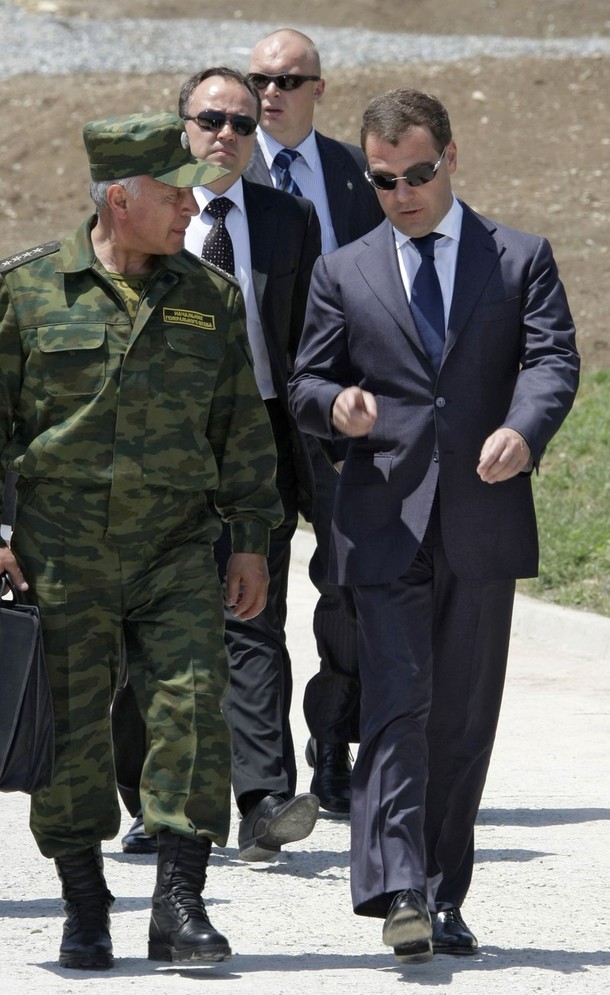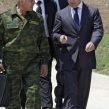
Russia Quietly Introduces “New Look” Army
Publication: Eurasia Daily Monitor Volume: 6 Issue: 134
By:

The Russian MoD controlled Zvezda TV reported on July 9 that the Far Eastern Military District (MD) is preparing its largest redeployment of hardware since World War II as part of an "anti-terrorist" exercise with China. On 22 July the Russian armed forces will jointly conduct Peace Mission 2009 with the People’s Liberation Army over five days in western China. Around 1,300 Russian servicemen and more than 160 units of hardware, including T-80 tanks, infantry fighting vehicles and self-propelled artillery pieces will participate in the exercise. Zvedza TV displayed rows of tanks and other hardware being loaded on rail cars at the Grodekovo station on the trans-Siberian railroad.
On the same day, an advanced unit from the Russian military arrived at the Taonan tactical training base in Jilin province and held meetings with the PLA’s Major-General Gong Jicheng and officers within the Shenyang military command. These preparations were scheduled to be finalized on July 22 during a meeting in Khabarovsk between the Russian Chief of the General Staff Army-General Nikolai Makarov and his Chinese counterpart General Chen Bingde (Xinhua, July 9). However, such bilateral military exercises are currently part of the Russian MoD’s campaign to convey an image of "business as usual," while its conventional forces are radically overhauled.
This image which disguises an underlying sense of chaos within the structures being reformed is most evident during Russian exercises. On July 6 as Barack Obama arrived in Moscow to hold talks with Russian President Dmitry Medvedev and Prime Minister Vladimir Putin all domestic TV networks reported on the final stages of Kavkaz 2009, which began on June 29. Over 8,500 servicemen, around 1,000 pieces of hardware, fighters, helicopters, as well as ships from the Black Sea Fleet and the Caspian Flotilla were deployed. The North Caucasus MD spokesman Andrey Bobrun said that in the course of the naval tactical exercises, cooperation and communications were the key priorities. Part of the exercise was held in Georgia’s breakaway regions of Abkhazia and South Ossetia. Once again, sources within the Russian MoD characterized the exercise as one of the largest since the disintegration of the Soviet Union. While it was designated as an "antiterrorist" exercise, it appeared remarkably similar to Kavkaz 2008, and was clearly intended to send a powerful coercive signal to Tbilisi. More importantly, it also tested the new brigade structures being introduced throughout the Russian army (Interfax, July 6).
According to the scenario international terrorists, after crossing the state border and attacking from several directions as well as from the sea, captured several areas in the North Caucasus. However, communications and reconnaissance units were deployed throughout the exercise areas one week in advance in order to rehearse assisting in locating the "terrorists." The array of firepower certainly fitted the projection of both the political warning to Georgia and that the military remains capable of repelling "aggression." This included the use of airpower and armored hardware. A motor-rifle brigade was shown entering the battlefield following air strikes which apparently failed to deter the enemy forces’ efforts to "penetrate deeply" into Russian territory; despite this, the enemy was completely destroyed within two and a half hours, with tanks and motor-rifle brigades used as the terrorists attempted to breach the encirclement (Vesti TV, Rossiya TV, July 6). One of the main elements of the exercise occurred at the Sernovodskoye range in Stavropol as a separate motor-rifle brigade from Budennovsk rehearsed repelling an attack. Su-24 frontline bombers and Su-25 fighters launched airstrikes against enemy positions, with additional airpower being supplied by Mi-24 helicopters.
Officers from the main combat training directorate told the press that the forces were "experimenting" with the new organizational and personnel structure in order to determine their optimal use. They specifically tested the ability of forward-deployed battalions to fulfil required missions at a distance from the bulk of the brigade forces (Zvevda TV, July 6). It appears that drawing on the lessons learned from the Georgian war, these new structures were also paying closer attention to enhancing operational synergy between the branches of the armed forces.
According to the deputy head of the main directorate for combat training Colonel-General Aleksandr Larchenko Kavkaz 2009 revealed a number of shortcomings for the new structures: "There are problems concerning communications, that is to say, command and control; there are challenges involving the organization of closer cooperation; and the operation of individual subunits away from the bulk of the brigade forces, at a distance of 15-20 or more kilometres" (NTV Mir, July 6). Commanders focussed on assessing the level of cooperation between the army subunits and airborne forces (VDV), FSB border troops and interior ministry forces.
In reality the Russian conventional armed forces are currently in organizational chaos as the transition to the new brigade-based structure proceeds. Prior to Kavkaz 2009, 46 brigades were already formed, with the remaining 44 scheduled to be formed by December 1. In other words, the table of organization within the Russian army has already passed the point of no return, after which it will be dangerous to unpick the reforms; in June the concept of mass mobilization passed quietly into Russian history. Unfortunately, from the perspective of the MoD leadership the very structures that have emerged (brigades) are struggling to achieve key goals ranging from battalions operating independently of the brigade to enhancing communications and reconnaissance, while the reformed command and control structures also reveal deficiencies. In this sense, it explains General Makarov’s assertion in his speech on June 5 that the reform of the conventional forces is being carried out under the "nuclear umbrella" (Interfax, June 5). In conventional terms, in the event of an emergency, the VDV and special forces, in conjunction with FSB border troops and elements of the Russian air force would form the backbone of any response.
The imagery and rhetoric currently surrounding Russian military exercises appears designed to conceal the true weakened condition of the conventional forces, while its defense leadership and commanders struggle to "optimize" these new and unfamiliar structures. This situation will likely persist well into 2010, and compel additional changes to the hardware and weaponry inventory designed to maximize conventional firepower.




